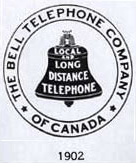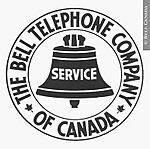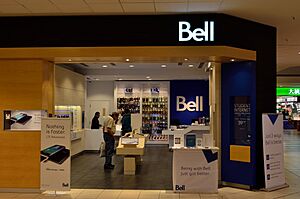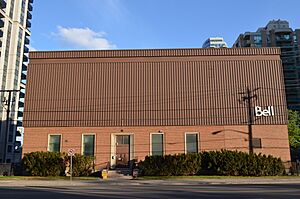Bell Canada facts for kids
 |
|||
|
Formerly
|
The Bell Telephone Company of Canada, Ltd. (1880–1968) | ||
|---|---|---|---|
| Subsidiary | |||
| Industry | Telecommunications | ||
| Founded | April 29, 1880 | ||
| Founders | Charles Fleetford Sise | ||
| Headquarters | Verdun, Quebec, Canada | ||
|
Area served
|
Canada | ||
|
Key people
|
Mirko Bibic (CEO) | ||
| Products | |||
| Revenue | |||
|
Operating income
|
|||
|
Number of employees
|
|||
| Parent |
|
||
| Subsidiaries |
|
||
|
|||
Bell Canada, often just called Bell, is a big Canadian company that provides phone, internet, and TV services. Its main office is in Verdun, Quebec, Canada.
Bell is the main phone company in Ontario and Quebec. It also offers services to businesses in western Canada. Its company, Bell Aliant, helps customers in the Atlantic provinces. Bell also provides mobile phone service through Bell Mobility (which includes Virgin Plus). For TV, it offers Bell Satellite TV and Bell Fibe TV.
Bell Canada's main rivals are Rogers Communications and Telus Communications. In Quebec, Quebecor (Videotron) is also a big competitor. Bell serves over 13 million phone lines across Canada.
Bell Canada is a major part of a larger company called BCE Inc.. BCE also owns Bell Media, which runs TV channels like CTV Television Network. BCE also has stakes in sports teams like the Montreal Canadiens hockey club.
Contents
History of Bell Canada
Bell Canada has always been one of Canada's most important companies. In 1975, it was the fifth largest company in the country. The company is named after Alexander Graham Bell, who invented the telephone. He also helped start the Bell Telephone Company in the United States. Bell Canada was part of the larger Bell System in the U.S. from 1880 to 1975.
How Bell Canada Started
In the 1870s, Alexander Graham Bell, who lived in Canada, invented a device that could send and receive human speech. This invention later became known as the telephone. Bell patented his invention in the United States and Canada. He gave 75% of his Canadian patent rights to his father, Alexander Melville Bell.
For a few years, Bell's father and his friend, Thomas Philip Henderson, collected money from renting telephones. People either used their own private phone lines or paid another company for service.
In 1879, Bell's father sold his Canadian rights to the National Bell Telephone Company in the U.S. This company later became the American Bell Telephone Company in 1880. That same year, the Canadian part was renamed "The Bell Telephone Company of Canada Ltd." Charles Fleetford Sise from Chicago became its first general manager.
The first company to supply telephones to Bell in Canada was in Brantford, Ontario. It was started by Thomas C. Cowherd and his son James. They were friends with Alexander Graham Bell and helped him with his early telephone tests. They built about 2,398 telephones for the Canadian market.
By 1914, The Bell Telephone Company of Canada had a special right from the government to offer long-distance phone service. It served 237,000 customers. On March 7, 1968, the company's name officially changed to Bell Canada.
Growing and Changing Areas

Bell Canada expanded its phone lines across Canada, from Nova Scotia to the Rocky Mountains. However, it focused mostly on big cities in Ontario, Quebec, and the Maritimes.
Atlantic Canada
In the late 1800s, Bell sold its operations in the three Maritime provinces. Many smaller phone companies also existed there. These smaller companies eventually joined together under three provincial companies. Bell later bought parts of all these Atlantic companies in the 1960s.
In the late 1990s, these companies merged to form Aliant, now called Bell Aliant. Bell Aliant now owns many services in rural parts of Ontario and Quebec that used to belong to Bell Canada.
Quebec and Ontario
Many independent phone companies appeared in Ontario, Quebec, and the Maritimes where Bell Canada didn't offer enough service. Over time, Bell bought most of these independent companies in Ontario and Quebec. Today, some rural areas in Quebec are served by Telus Québec or Télébec (which Bell Canada now owns). Ontario still has about 30 independent companies that Bell has not bought.
Western Canada
Over time, the provinces of Alberta, Manitoba, and Saskatchewan took over Bell Canada's operations in their areas. They wanted to improve phone services across their provinces. Alberta and Manitoba bought Bell's operations in 1908. Saskatchewan bought them in 1909. These provincial companies then bought the smaller independent companies.
Manitoba later made its phone company private, and Alberta did the same, creating Telus Communications. Saskatchewan still owns its phone company, SaskTel, which is run by the government. In 2017, BCE Inc. bought back the Manitoba system, now known as Bell MTS.
British Columbia was served by many small companies that joined to form British Columbia Telephone, or BC Tel. This company later merged with Telus.
Northern Canada
Bell Canada started service in the Northwest Territories in 1958. However, most phone service in Canada's northern territories (Yukon, northern BC, and western NWT) was provided by Canadian National Telecommunications. This company created Northwestel in 1979. Bell Canada Enterprises bought Northwestel in 1988. Bell Canada later sold its eastern NWT operations to Northwestel in 1992.
Changes and New Rules
The Bell System in the U.S. had two main companies in Canada: Bell Canada (for phone services) and Northern Electric (for making equipment). In 1956, the Bell System in the U.S. had to sell Northern Electric.
In 1973, AT&T and Bell Canada agreed that AT&T would no longer share its research with Bell Canada. This was because Bell Canada had developed its own research lab. So, AT&T sold its part of Bell Canada on June 30, 1975.
Northern Electric changed its name to Northern Telecom in 1976, and then to Nortel Networks in 1998.
In 1983, because of new rules, BCE was created as the main company for Bell Canada and Northern Telecom. Later, BCE sold its share of Nortel to its shareholders in 2000.
Between 1980 and 1997, the Canadian government changed the rules for the phone industry. This meant Bell Canada no longer had a monopoly (being the only provider). Today, Bell Canada offers local phone service mainly in big cities in Ontario and Quebec.
In 2006, Bell and its former company Aliant changed how they worked. Aliant, renamed Bell Aliant Regional Communications, took over Bell's wired phone services in many parts of Ontario and Quebec. Bell took over Bell Aliant's wireless and retail services.
In 2007, the CRTC (the Canadian government group that regulates broadcasting and telecommunications) allowed pay phone rates to increase. Bell Canada raised the cost of a local pay phone call to 50 cents in cash. This was Bell's first increase in pay phone rates since 1981.
In 2009, Bell Canada bought the electronics store chain The Source.
Services Bell Canada Offers
Bell Canada provides many different types of communication services.
Phone Services
Bell Canada offers regular phone service for homes. It also provides digital voice services for businesses.
Voicemail
Bell Home Phone and Bell Mobility offer voicemail as an extra feature for homes and businesses. Bell Prepaid customers get a basic voicemail for free.
Wireless Services
Bell Mobility runs a cell phone network across all Canadian provinces. It also owns Virgin Mobile Canada. Bell used to have a brand called Solo Mobile, but it stopped selling new Solo phones in 2011.
Television Services
Bell Satellite TV is a service that provides TV channels through satellites. There is also Bell Mobile TV for phones and Bell Fibe TV for TV over the internet. Bell Fibe TV is available in many parts of Canada, including Alberta, British Columbia, and major cities like Toronto and Montreal.
Internet Services
Bell Internet offers high-speed internet using DSL and fiber optic cables. Speeds can range from 500 kilobits per second (kbit/s) to 8 gigabits per second (Gbit/s), depending on the area.
Bell started offering "Fibe" internet in 2010, which uses fiber optic technology. Many city areas with Fibe can get very fast speeds. Bell Canada has also rolled out Fibre to the Home services in Eastern Canada, offering speeds up to 3 Gbit/s.
In August 2019, Bell announced it would reduce a rural internet expansion program. This happened after a government regulator lowered the prices that big telecom companies could charge smaller internet providers.
In February 2022, Bell announced it bought the internet company EBOX. Bell plans to keep EBOX operating on its own.
Past Services
Bell used to offer a home monitoring service called Bell Home Monitoring or Bell Gardium.
Bell Canada also offered cable TV services in the United Kingdom from 1994 to 1997.
How Bell Canada Advertises
Bell Canada used two beaver characters, Frank and Gordon, in its advertisements from 2006 to 2008.
Around the 2008 Beijing Olympics, Bell introduced a new logo and simple ad style. Their English slogan was "Today just got better." In French Canada, the slogan was "La vie est Bell," which is a play on words meaning "life is beautiful."
Leadership at Bell Canada
Presidents
- Andrew Robertson, 1880–1890
- Charles Fleetford Sise, 1890–1915
- Lewis Brown McFarlane, 1915–1925
- Charles Fleetford Sise, Jr., 1925–1944
- Frederick Johnson, 1944–1953
- Thomas Wardrope Eadie, 1953–1963
- Marcel Vincent, 1963–1968
- Robert Carleton Scrivener, 1968–1973
- Albert Jean de Grandpré, 1973–1976
- James Carden Thackray, 1976–1983
- Joseph Victor Raymond Cyr, 1983–1986
- Léonce Montambault, 1987–1989
- Jean Claude Monty, 1989–1991
- Robert Kearney, 1991–1993
- John Thomas McLennan, 1994–1997
- Ronald Walter Osborne, 1997–1998
- John Alexander MacDonald, 1998–1999
- John William Sheridan, 2000–2003
- Michael John Sabia, 2000–2005
- George Alexander Cope, 2005–2020
- Mirko Bibic, 2020–present
Chairmen of the Board
- Lewis Brown McFarlane, 1925–1930
- Charles Fleetford Sise, Jr., 1944–1953
- Frederick Johnson, 1953–1957
- Thomas Wardrope Eadie, 1957–1968
- Marcel Vincent, 1968–1972
- Robert Carleton Scrivener, 1973–1976
- Albert Jean de Grandpré, 1976–1983
- James Carden Thackray, 1983–1985
- Joseph Victor Raymond Cyr, 1986–1996
- Lynton Ronald Wilson, 1996–
- Jean Claude Monty, –2002
- Richard James Currie, 2002–2009
- Thomas Charles O'Neill, 2009–2016
- Gordon Melbourne Nixon, 2016–present
Related Topics
- American Telephone & Telegraph, also known as AT&T, was an earlier parent company.
- Bell Centre, a sports arena in Montreal.
- Bell Mobility, Bell Canada's wireless services division.
- Bell System, the group of companies led by Bell Telephone and AT&T that provided phone services.
- Bell Telephone Memorial, a monument honoring the telephone inventor in Brantford, Ontario.
- International Bell Telephone Company, Bell Telephone's early European division.
- National Bell Telephone Company, the very first parent company.
- Thomas Cowherd, who helped start Canada's first telephone factory.









